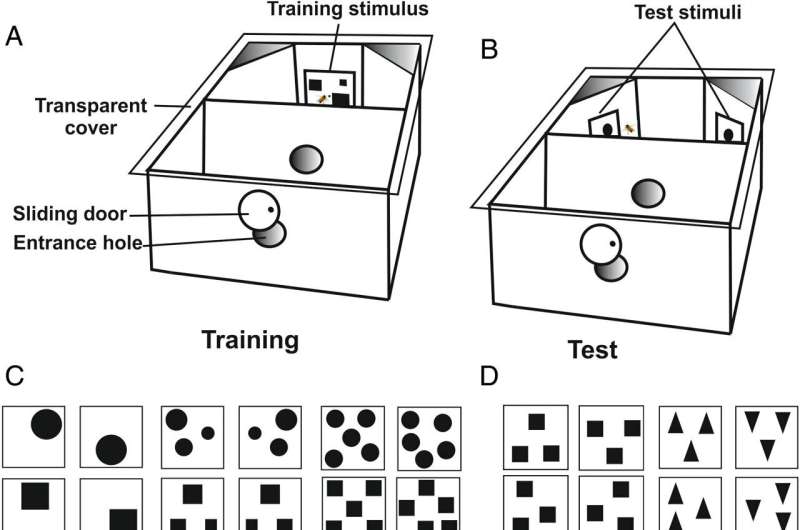(A) Overall view of the experimental setup during training. The wooden box was covered by a transparent cover, which allowed observing the behavior of the bees accessing the inner compartments. After passing the first inner compartment, the focal bee faced a training stimulus placed in the middle of the back wall. An Eppendorf tip delivered sucrose solution in the middle of the image. (B) Overall view of the experimental setup during a test. After passing the first inner compartment, the focal bee faced two lateral walls displaying the same test alternative on each side. The test stimuli were novel to the trained bee, i.e. they were never experienced during the training. No reward was provided during the test. The first choice and the cumulative choices performed during 40 s were recorded. (C) Examples of stimuli used in the first and second experiment. (D) Stimuli used in the third experiment. (E) Examples of stimuli used in the fourth experiment. Credit: Proceedings of the National Academy of Sciences (2022). DOI: 10.1073/pnas.2203584119
A small team of researchers with members from the University of Toulouse, the University of Lausanne and the University of Padova has found evidence that honeybees have a mental number line in their tiny brains. In their paper published in Proceedings of the National Academy of Sciences, the group describes experiments they conducted with captive honeybees.
Prior research has suggested that in to addition humans, baby chickens possess what scientists call a mental number line. Numbers of things are represented in the brain and are processed in a left-to-right direction. For example, when most people are asked to sort piles of grapes by the number, most do so from left to right, with the smallest pile on the left. In this new effort, the researchers wondered whether honeybees might also use a mental number line to keep track of things. To find out, they conducted a two-stage experiment.
The first stage of the experiment involved teaching a group of honeybees to associate a number (one, three or five) with a sugar water reward using blocks taped to a wall inside of a cardboard box. They ensured that the bees were not associating a reward with shapes by varying size and shape. Once the bees had learned their associations, the researchers conducted the second part of the experiment.
It consisted of setting up two panels inside of the training box with taped blocks. The two panels were set horizontally to allow for reading left to right or vice versa. Next, the bees were introduced into the box while the researchers watched to see which panel they would choose to find their reward.
The researchers found that 72% of the time, the bees trained on the number "one" chose a "three" panel on the right. Seventy-three percent of the time, bees trained on the number "five" chose the "three" panel on the left. They claim this shows that the bees were using a mental number line to keep track of the numbers. They further suggest that the idea of keeping track of numbers using a mental number line is likely prevalent in a wide variety of animals.
More information: Martin Giurfa et al, An insect brain organizes numbers on a left-to-right mental number line, Proceedings of the National Academy of Sciences (2022). DOI: 10.1073/pnas.2203584119
Journal information: Proceedings of the National Academy of Sciences
© 2022 Science X Network
























